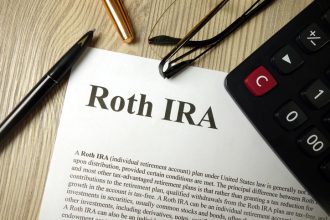The IRS mandates withdrawals from pre-tax retirement accounts once you reach a certain age. These are referred to as required minimum distributions (RMDs). For many retirees, RMDs don’t change much since they already take out more than the minimum to cover living costs. But, for those who want to withdraw less than the required amount or leave money invested, RMDs can pose a challenge. To help you calculate how much to withdraw from your own retirement accounts, let’s walk through an example of a 78-year-old with $735,000 in a 401(k).
A financial advisor can help you calculate your RMDs, plan withdrawals around taxes and decide how to use or reinvest the money.
How Is Your RMD Amount Determined?
Starting at age 73, the IRS requires you to withdraw a minimum amount each year from pre-tax retirement accounts such as 401(k)s and traditional IRAs. These RMDs do not apply to taxable investment accounts or Roth IRAs for original owners1. You can delay your first RMD until April 1 of the year after you turn 73. If you do this, however, you’ll be required to take two distributions in that same year (the postponed amount and the regular RMD).
You can withdraw more than the required amount if you choose, but the RMD itself cannot be rolled into another retirement account. Any extra above the RMD can be transferred or converted. Most people either take the withdrawal as cash or move the funds into a taxable account.
RMDs are calculated separately for each account type. For example, if you hold both a traditional IRA and a 401(k), you must calculate an RMD for each. You can combine and take IRA RMDs from one or more IRA accounts, but RMDs from 401(k) plans must be withdrawn from each plan individually. The full annual RMD must be taken by December 31, except in the first year you turn 73, when you may delay until April 1 of the following year.
The IRS bases RMD calculations on your age and your account balance at the end of the previous year. Using the life expectancy tables2, you divide your balance by the distribution period for your age.
As an example, let’s say that you are 75 in 2025 with a $1 million balance in your 401(k). Your distribution period is 24.6, and dividing your 401(k) balance by that period, your RMD would be $40,650 for 2025.
Now, for a comparison, if we take the example from the introduction of a 78-year-old with $735,000 in a 401(k), the RMD would be $33,409 (divide the balance of 735,000 buy the distribution period of 22).
How Do You Plan for RMDs?

For retirees who already withdraw enough to cover living expenses, RMDs may not create extra planning challenges. But, if you prefer to withdraw less or leave funds invested, the rule forces you to take money out and pay taxes on it, even if you don’t need it.
To figure out the tax impact on an RMD, let’s use the example of a 75-year-old with $1 million in a 401(k). As we already calculated before, the RMD for the year would be about $40,650. Since this is pre-tax money, the IRS treats the full withdrawal as taxable income.
- Step 1: Tax the first $11,925 of the RMD at 10% ($11,925 × 0.10) = $1,192.50
- Step 2: Subtract this amount from the total RMD ($40,650 – $11,925) = $28,725
- Step 3: Tax the remainder at 12% ($28,725 × 0.12) = $3,447
- Step 4: Add both amounts for total tax ($1,192.50 + $3,447) = roughly $4,640 in federal tax.
This works out to an effective tax rate of roughly 11.4% on your RMD. While that percentage may not seem large, it reduces how much of your withdrawal is available to spend or reinvest. If you also receive Social Security, pension income, or other taxable distributions, your total income could move you into higher tax brackets, which would increase your overall liability.
Example: How to Plan for RMDs at 78 With $735,000 in a 401(k)
If any RMDs were missed, calculate the amounts that should have been withdrawn and take those withdrawals now, then file IRS Form 5329 to report the shortfall. You can request a waiver of the excise tax for reasonable error after making the makeup distributions.
Once that’s settled, check if your usual withdrawals already cover your RMD. For example, in 2025 a $735,000 balance at age 78 requires about $33,409 based on the IRS table. If you take out that much or more, you’re fine. If you take less, increase withdrawals to meet the RMD. And for readers just starting at 73, delaying the first RMD until April 1 of the next year means you’ll need to take two withdrawals that year.
Remember, if you want to keep assets invested, you still have to take the RMD directly from the 401(k), since 401(k) RMDs can’t be combined with IRAs. After the withdrawal, however, you can move the money into a taxable account to reinvest. Only amounts above the RMD can be rolled over or converted to a Roth.
Now, using the RMD amount from the example, let’s calculate how much you would owe in taxes for $33,409:
- Step 1: Tax the first $11,925 of the RMD at 10% ($11,925 × 0.10) = $1,192.50
- Step 2: Subtract this amount from the total RMD ($33,409 – $11,925) = $21,484
- Step 3: Tax the remainder at 12% ($21,484 × 0.12) = $2,578.08
- Step 4: Add both amounts for the total tax ($1,192.50 + $2,578.08) = roughly $3,771 in federal tax.
That works out to an effective tax rate of roughly 11% on your RMD.
Some retirees consider Roth conversions after taking their RMDs, if they want to reduce future taxes or leave tax-free assets to heirs. The trade-off is that conversions increase current-year income and may move you into a higher bracket.
Using the same example of $735,000 in a 401(k) at age 78, if you only take the RMD of $33,409, your federal tax liability as a single filer would be roughly $3,771. But, if you also convert an additional $20,000 from your 401(k) to a Roth IRA, your taxable income for the year rises to $53,409.
Here are the steps to calculate your taxes on the conversion:
- Step 1: Tax the first $11,925 at 10% ($11,925 × 0.10) = $1,192.50
- Step 2: Subtract this amount from the total ($53,409 – $11,925) = $41,484
- Step 3: Tax the next $36,550 (up to $48,475) at 12% ($36,550 × 0.12) = $4,386.00
- Step 4: Subtract this portion from the remainder ($41,484 – $36,550) = $4,934
- Step 5: Tax the remainder at 22% ($4,934 × 0.22) = $1,085.48
- Step 6: Add all tax amounts together ($1,192.50 + $4,386 + $1,085.48) = roughly $6,664 in federal tax.
In this example, the Roth conversion increases your tax bill by about $2,893. But it allows the converted $20,000 to grow tax-free and eventually get withdrawn or passed on to heirs without additional income tax. If you need the money soon, you can take only the RMD and reinvest it in a taxable account.
Bottom Line

If you’re over 73, managing RMDs starts with confirming that you’ve taken the right amounts in past years to avoid penalties. From there, think about what matters most to you—whether it’s covering living expenses, reducing taxes, leaving money to heirs, or converting some funds to a Roth account. Your priorities will guide how you time and structure withdrawals.
Tax Planning Tips for Retirement
- A financial advisor can help you determine whether you have enough saved for retirement and recommend strategies to preserve and grow your nest egg. Finding a financial advisor doesn’t have to be hard. SmartAsset’s free tool matches you with vetted financial advisors who serve your area, and you can have a free introductory call with your advisor matches to decide which one you feel is right for you. If you’re ready to find an advisor who can help you achieve your financial goals, get started now.
- If you’re looking for an easy way to figure out your retirement account distributions, SmartAsset’s RMD calculator can help you get an estimate.
Photo credit: ©iStock.com/Drazen Zigic, ©iStock.com/Andrii Dodonov, ©iStock.com/Drazen Zigic
Read the full article here
















